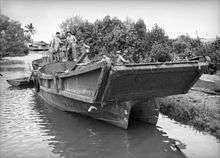Daihatsu-class landing craft
| Class overview | |
|---|---|
| Name: | Daihatsu class |
| Operators: |
|
| In service: | 1937–1945 |
| Planned: | 3,229 |
| General characteristics (Daihatsu-class landing craft) | |
| Type: | Landing craft |
| Tonnage: | 21 tons |
| Length: | 47 ft (14.33 m)o/a |
| Beam: | 10 ft (3.05 m) |
| Draught: | 2.6 ft (0.79 m) |
| Installed power: | 60 hp (45 kW) |
| Propulsion: | Diesel engine |
| Speed: | 8 knots (14.8 km/h) |
| Range: |
|
| Capacity: | 1 Type 95 7.4 ton tank or 70 men or 10 tons cargo |
| Complement: | 12 |
| Armament: | 2 light machine guns or 2-3 25mm/60 AA guns |
The Daihatsu-class or 14 m landing craft (大発, abbreviation of 大型発動機艇 which means "large motorized boat") was a type of landing craft used by the Imperial Japanese Army from 1937 to 1945, in the Second Sino-Japanese War and World War II. It had a bow ramp that was lowered to disembark cargo upon riding up onto a beach. After reviewing photos of a Daihatsu landing craft, this was adopted by American landing craft designer Andrew Higgins in developing the Landing Craft, Personnel (Large) (LCP(L)) into the Landing Craft, Personnel (Ramped) (LCP(R)) and later the Landing Craft, Vehicle and Personnel (LCVP). However, the Daihatsu landing craft was more seaworthy than an LCVP due to its hull design. It was constructed of a metal hull and powered by a diesel engine.
The landing craft could be modified to carry weapons of up to 37 mm (1.46 inch) caliber as armament and could be uparmoured against 40 mm fire.

References
- Jentschura, Hansgeorg; Jung, Dieter; and Mickel, Peter. Translated by Brown, J.D. 1977. Warships of the Imperial Japanese Navy, 1869-1945. Naval Institute Press. ISBN 0-87021-893-X.
- Morison, Samuel Eliot. 1950. History of United States Naval Operations in World War II, Volume VI: Breaking the Bismarck Barrier, 22 July 1942 – 1 May 1942. Boston: Little, Brown, and Company.
- Parillo, Mark P. 1993. The Japanese Merchant Marine in World War II. Naval Institute Press. ISBN 1-55750-677-9